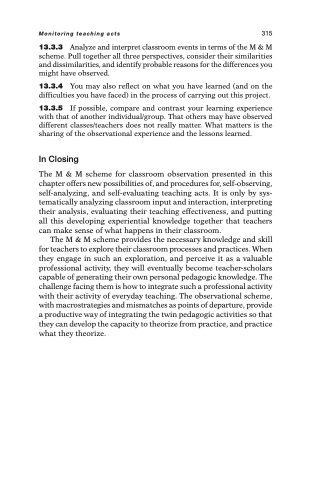Page 327 - Beyond Methods
P. 327
Monitoring teaching acts 315
13.3.3 Analyze and interpret classroom events in terms of the M & M scheme. Pull together all three perspectives, consider their similarities and dissimilarities, and identify probable reasons for the differences you might have observed.
13.3.4 You may also reflect on what you have learned (and on the difficulties you have faced) in the process of carrying out this project.
13.3.5 If possible, compare and contrast your learning experience with that of another individual/group. That others may have observed different classes/teachers does not really matter. What matters is the sharing of the observational experience and the lessons learned.
In Closing
The M & M scheme for classroom observation presented in this chapter offers new possibilities of, and procedures for, self-observing, self-analyzing, and self-evaluating teaching acts. It is only by sys- tematically analyzing classroom input and interaction, interpreting their analysis, evaluating their teaching effectiveness, and putting all this developing experiential knowledge together that teachers can make sense of what happens in their classroom.
The M & M scheme provides the necessary knowledge and skill for teachers to explore their classroom processes and practices. When they engage in such an exploration, and perceive it as a valuable professional activity, they will eventually become teacher-scholars capable of generating their own personal pedagogic knowledge. The challenge facing them is how to integrate such a professional activity with their activity of everyday teaching. The observational scheme, with macrostrategies and mismatches as points of departure, provide a productive way of integrating the twin pedagogic activities so that they can develop the capacity to theorize from practice, and practice what they theorize.


